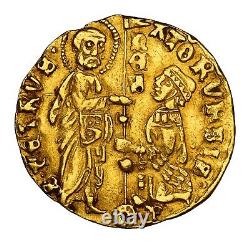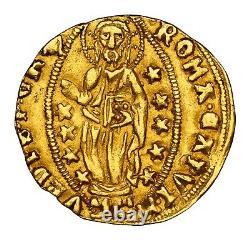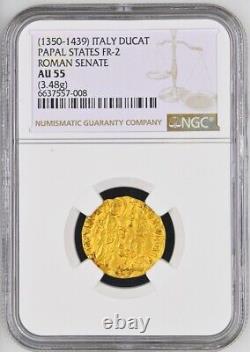1439, Papal States, Roman Senate. Gold Ducat (Zecchino) Coin. (3.48gm) NGC AU58





1439, Papal States, Roman Senate. Certified and graded by NGC as AU-58! Reference: Friedberg 2, Muntoni 129, MIR 179/23.
Denomination: Ducat (immitating a venetian type Zecchino) Diameter: 20mm Weight: 3.48gm Material: Gold! Peter standing right, holding book of gospels and presenting banner to kneeling senator.
Rosette beneath letter "P" below. / NES (vertical along banner).
Reverse: Christ standing facing, raising hand in benediction and holding Gospels, surrounded by elliptical halo containing nine stars. Facing head of John the Baptist.. Expanded: ROMA CAPUT MUNDI - S ENATUS P OPULAS Q UE R OMANUS Translated. Rome capital of the world. The Senate and People of Rome. SPQR is an initialism from a Latin phrase, S enatus P opulus q ue R omanus ("The Senate and People of Rome"), referring to the government of the ancient Roman Republic, and used as an official signature of the government. It appears on coins, at the end of documents made public by inscription in stone or metal, in dedications of monuments and public works, and was emblazoned on the standards of the Roman legions. D the words never vary, except for the spelling and inflection of populus in literature, Latin dictionaries classify it as a formula.Was a political institution in ancient Rome. It was one of the most enduring institutions in Roman history, being established in the first days of the city (traditionally founded in 753 BC).
It survived the overthrow of the kings in 509 BC, the fall of the Roman Republic in the 1st century BC, the division of the Roman Empire in 395 AD, the fall of the Western Roman Empire in 476 AD, and the barbarian rule of Rome in the 5th, 6th, and 7th centuries. During the days of the kingdom, it was little more than an advisory council to the king. The last king of Rome, Lucius Tarquinius Superbus, was overthrown following a coup d'état led by Lucius Junius Brutus, who founded the Republic. During the early Republic, the Senate was politically weak, while the executive magistrates were quite powerful.
Since the transition from monarchy to constitutional rule was most likely gradual, it took several generations before the Senate was able to assert itself over the executive magistrates. By the middle Republic, the Senate had reached the apex of its republican power. The late Republic saw a decline in the Senate's power, which began following the reforms of the tribunes Tiberius and Gaius Gracchus. After the transition of the Republic into the Principate, the Senate lost much of its political power as well as its prestige. Following the constitutional reforms of the Emperor Diocletian, the Senate became politically irrelevant, and never regained the power that it had once held.
When the seat of government was transferred out of Rome, the Senate was reduced to a municipal body. This decline in status was reinforced when the emperor Constantine the Great created an additional senate in Constantinople.
After the Western Roman Empire fell in 476, the Senate in the West functioned for a time under barbarian rule before being restored after the reconquest of much of the Western Roman Empire's territories during the reign of Justinian I. The Senate in Rome ultimately disappeared at some point after AD 603 (the year in which the last known senator was mentioned), although the title "senator" was still used well into the Middle Ages as a largely meaningless honorific. However, the Eastern Senate survived in Constantinople, until the ancient institution finally vanished there c.

